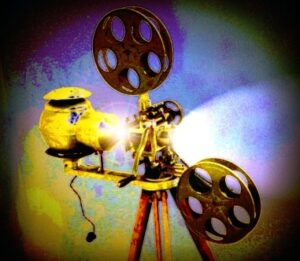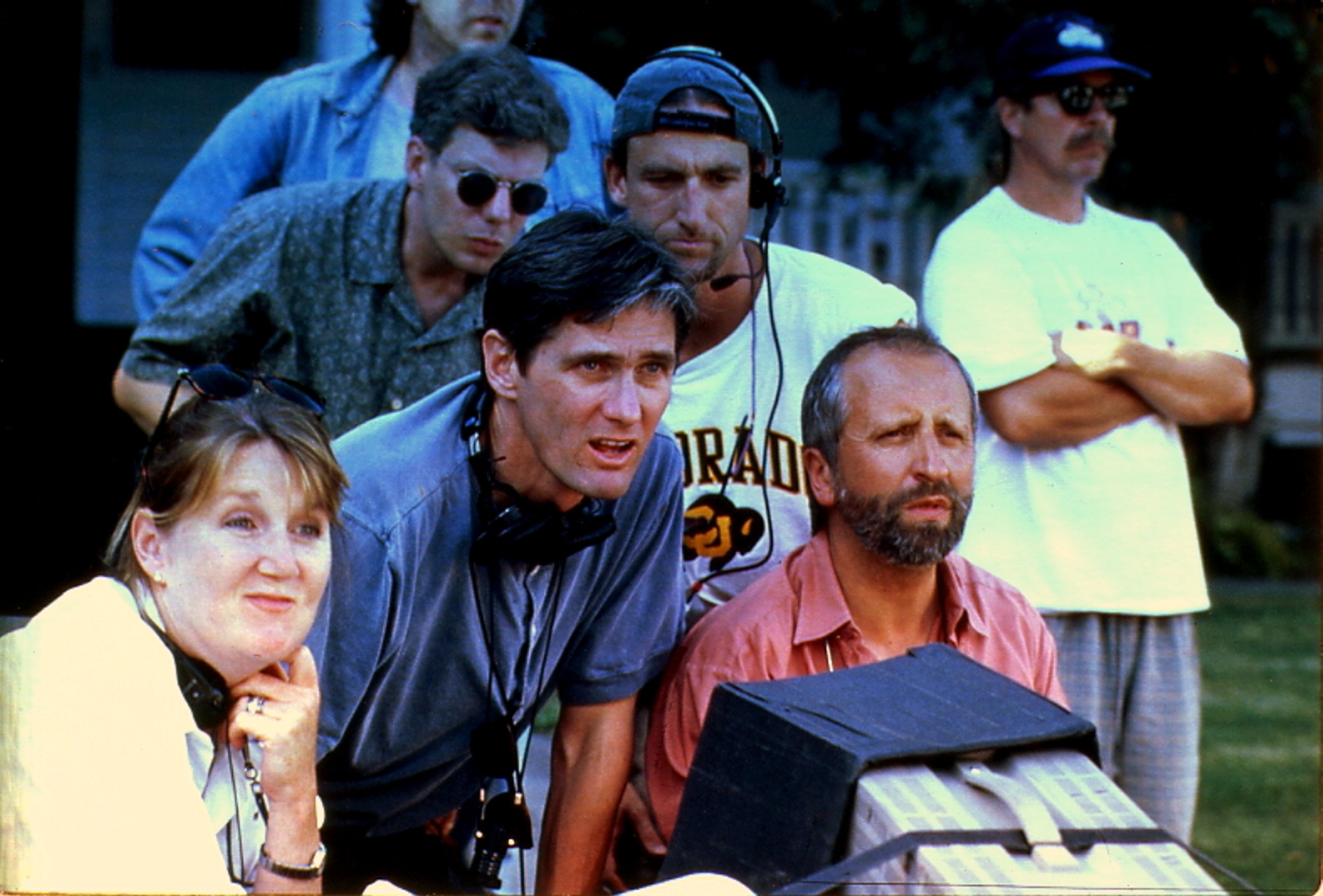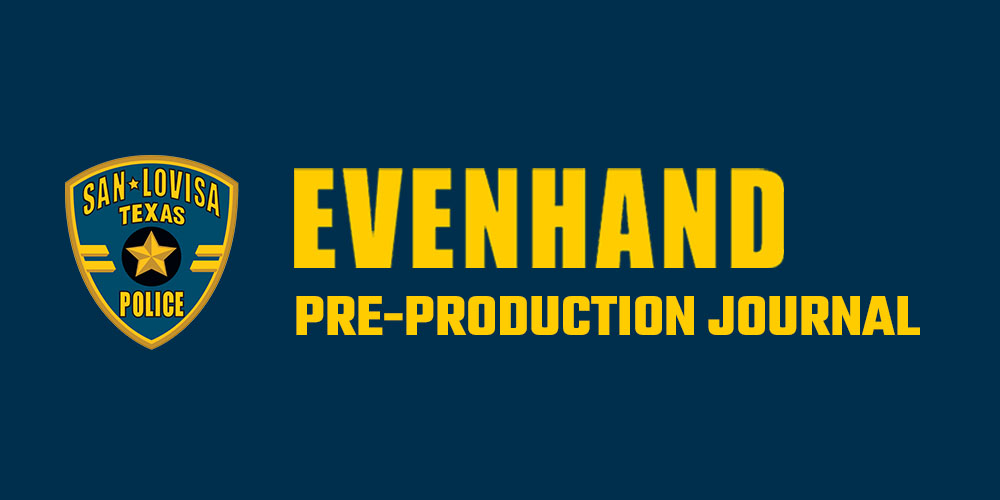
© 2000 J. Pierson
Jon and I have been giving a lot of thought to the choices we will have to make to bring EvenHand to the screen. Together we have made many films over the years, first as producers and more recently as co-directors. Our collective experience has taught us a great deal about the process of making a film — and the mistakes seem to result in the most enduring and indelible lessons.
Anyone who doesn’t know much about the nuts and bolts of filmmaking will be astonished by all the people milling around on a film set. A few can be seen bustling back and forth with lights and cables, but most seem to be standing next to the craft services table snacking on junk food and shooting the breeze. Others are hidden in trailers, creating or spreading gossip. But every one of these people has a very specific job to perform. The make-up artist may be chatting with the 1st camera assistant because she has finished touch-ups on the actors and he is waiting for the dolly track to be laid before he can get preliminary focus marks. To the casual observer, they are another pair of slackers standing around looking self-important, but their jobs are essential cogs in the machinery of filmmaking.
It’s also true, however, that the number of crew members found on a film set is in direct proportion to the budget of the film. The equation is pretty simple: the less money you have, the fewer people you can afford to hire. Big budget Hollywood film sets look like blue collar conventions; at the other end of the spectrum, student films often have no more than three or four people clustered around a tiny digital camera.
Our film experience has been closer to the Hollywood model, but when Jon and I first set out to produce Julian Po, we thought we could do things a bit differently. We planned to film in the Catskills with a non-union crew, so it seemed like a great opportunity to rethink the conventions of filmmaking. We would hire local craftsmen as carpenters and painters, giving the local economy a boost while saving ourselves money. Unable to afford an experienced production designer, the look of the film would emerge organically from the locations — necessity would become a creative asset.
I was frustrated at the time by the resistance we encountered to this unconventional approach to filmmaking. When we interviewed production managers, they invariably advised against “cutting corners” in this fashion. Some even said that it would not be possible to make the film for the small amount of money we had raised. The common theme in the advice we got was that it was a bad idea to mess with the existing conventions and hierarchy of film production.
Well, we never found out if our ideas had any merit. Christian Slater agreed to star in Po, and this resulted in the budget tripling, the unions hopping on board and a studio, New Line, financing the film. The process of making Julian Po was one of our more enduring learning experiences, but we’re proud of the film. You can rent it (or wait for it to pop up on IFC for the umpteenth time) and judge the results for yourself.

ON THE SET OF JULIAN PO
Dierdre (script supervisor), Joseph, Jon (chin), Alan Wade (director),
Jim LaClair (1st AD), Bernd Heinl (DP) & forgotten crew member
CUT TO: today. Here we are again, with a small amount of money and a great screenplay — and another opportunity to put our experience and accumulated wisdom to the test. EvenHand will be made as a non-union film. We will film on location, hiring local cast and crew. And we will buck many of the conventions of traditional filmmaking. The big difference is that now there is a recognized movement of filmmakers who have crafted a philosophy of “less is more” in their approach to making movies.
Anne Thompson has dubbed the movement “cinema purité” in a recent article in Premiere magazine (August 2000). The definition comes very close to describing our approach to making EvenHand: “Cinema purité confronts viewers with a kind of unfiltered reality…It plays with the cinematic conventions of time, point of view, format and performance. It’s about looking at real life — in unflinching close-up.” Lars Von Trier’s Dogma 95 is cited as just one example of a movement that embodies the principles of cinema purité.
One of the most gratifying moments in the article is a description of “authentic, unprettified locations” as a staple of cinema purité. I have been saying for months that I want the look of EvenHand to reflect the locations we find, as opposed to dressing them to create a new reality. I tend to apologize for not having a production designer on the film, although it’s not just a cost saving measure, but a conscious creative choice as well (just as it was meant to be on Po).
Time will tell if our newly ratified unconventional approach to filmmaking has any merit. I know it feels right to be spending less money, and it feels right to be more hands-on with all aspects of the process. I have always been a pain in the ass to most of the set crew on our films, because I tend to want to do everything myself. Now’s my big chance, I guess.
The bottom line is that no one cares how many grips you have on your film, or whether you shoot on sets or on location. No one cares about the minutæ of continuity or how many hours your actors spend in make-up. When pre-production begins, the most important thing you need to concern yourself with as a filmmaker is finding a consistent and clear vision governing all of your choices for the next few months. Every location, costume, actor, lens and film stock must speak to that vision. It doesn’t matter if you have a propmaster or a script supervisor, so long as you stay true to that vision and find a way to convey it in a compelling and original way.
– Joseph Pierson



